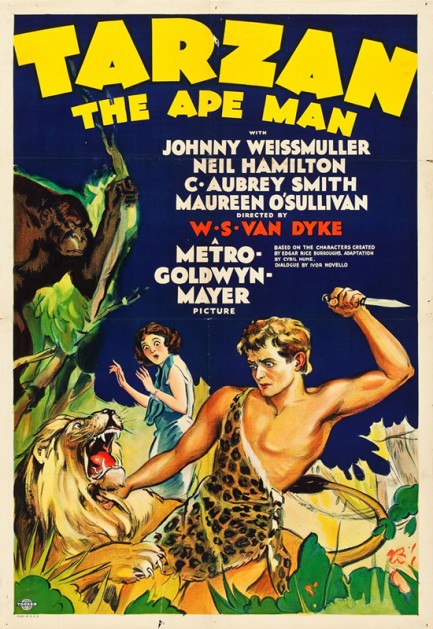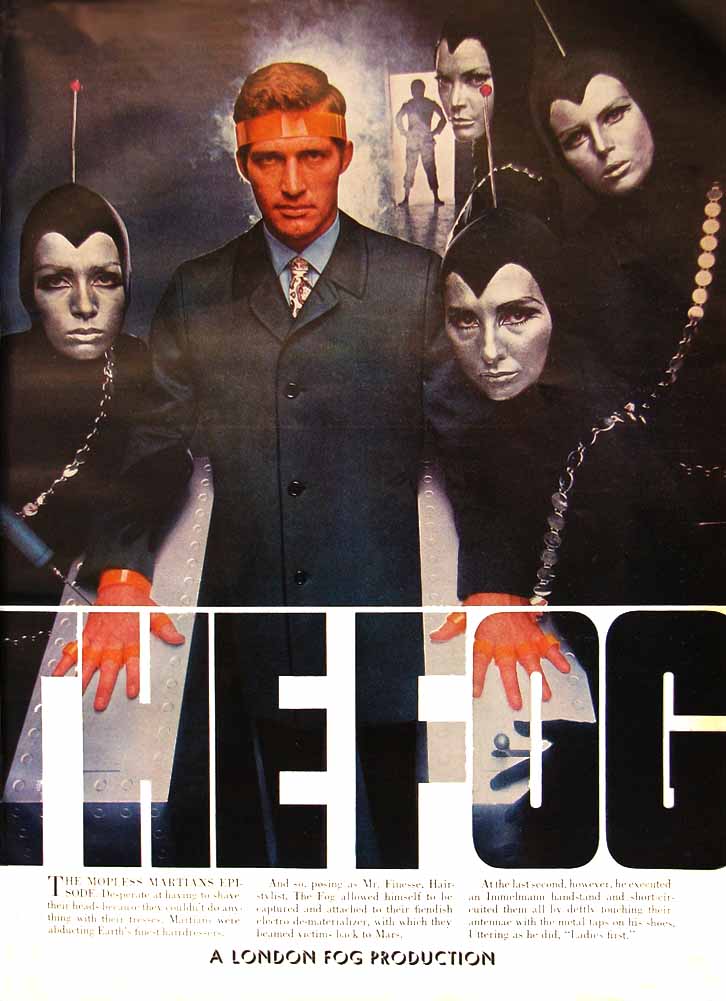 MGM's fantasy version of Africa goes swinging into northern Europe. 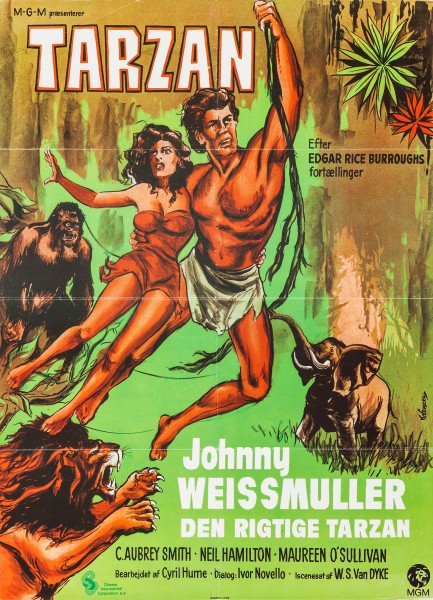
From up Scandinavia way comes this colorful borderless Danish poster for Tarzan the Ape Man, which starred Johnny Weissmuller and Maureen O'Sullivan. It was called simply Tarzan in Denmark, though Danes who've since seen it on DVD know it as Abemanden Tarzan. This was painted by Kurt Wenzel, whose signature you can see at the righthand margin, and who also painted well known posters for The Flying Tigers, The Killers, and The Searchers. We saw Tarzan for the first time last year and enjoyed it despite its flaws. We enjoyed the sequel too, equally flawed. Shorter version: watch it only with your historical accuracy and outrage filters turned off. After opening in the U.S. in March 1932, Tarzan premiered in Denmark today the same year.
 Weissmuller's jungle classic continues to look weirder as time goes by. 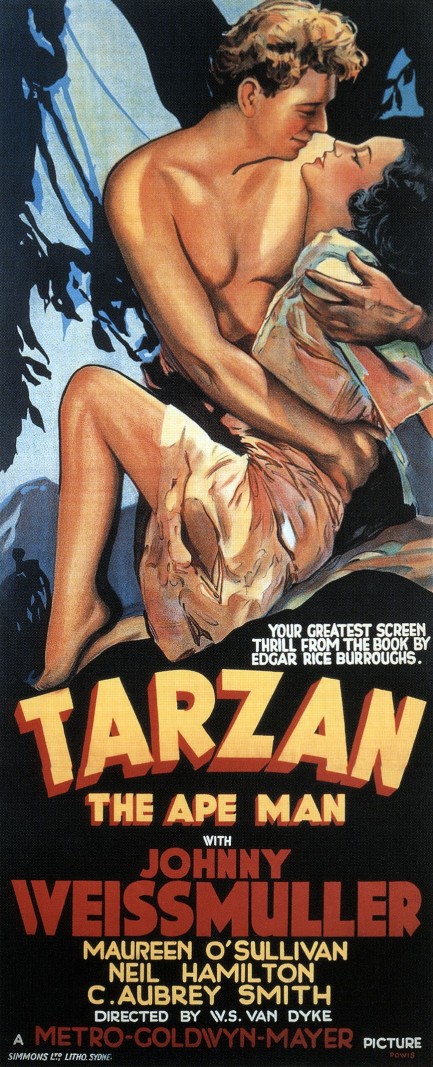
Above is a beautiful poster for Tarzan the Ape Man, which starred Olympic swimmer Johnny Weissmuller as Tarzan and twenty-one year old Maureen O'Sullivan as Jane Parker. The plot here is simple. White explorers are desperate to find a million pounds of ivory they believe lies hidden in an elephant graveyard somewhere in the African interior. After scaling a massive escarpment (and losing a native bearer over the side), and traversing a river (and losing native bearers to rubber hippos and crocs), and stumbling across a tribe of dwarfs (and losing a native bearer to an arrow), they finally reach the right area—and promptly lose Jane to Tarzan. Although he's carried her away against her will, she and Sir Loincloth eventually establish a rapport. And no wonder—this particular Tarzan is handsome, has good hair, and a physique in top maintenance.
Tarzan the Ape Man was made way back in 1932, but it isn't the first Tarzan film, or even the fifth or the eighth. But this effort from MGM, with its somewhat detailed sets, scanty costuming, and numerous animal co-stars, was the first that was a big hit. The shooting took place in various locations around Southern California and Florida, although there is some legit African stock footage used in spots, and, according to some sources, some second unit stuff from Mexico. For the era it must have been pretty convincing, rubber hippos and all. 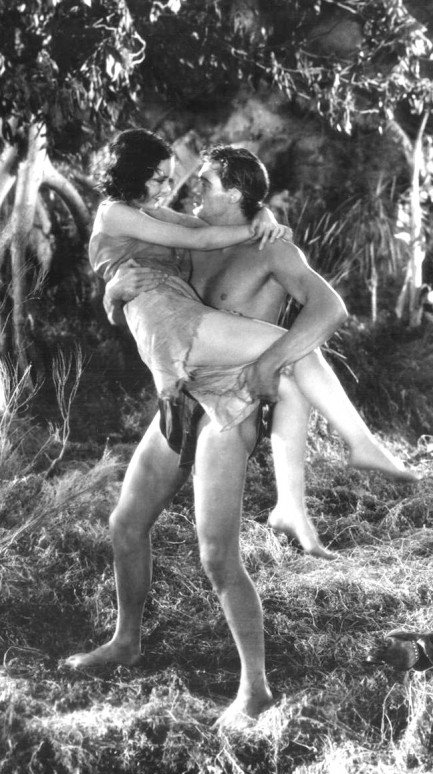 Needless to say, this flick is not flattering to Africans, African Americans, or African anyones. As for what the little person community thinks about fifty of their number covered in shoe polish, you'd have to ask a little person. We don't know any. But we seriously doubt they like it. Needless to say, this flick is not flattering to Africans, African Americans, or African anyones. As for what the little person community thinks about fifty of their number covered in shoe polish, you'd have to ask a little person. We don't know any. But we seriously doubt they like it.
As we are all part of the same human family, we all should feel empathy as we would if a brother or beloved cousin were insulted. Seems to us we've made halting progress on that front. What hasn't progressed at all is agreement about how to deal with literally trillions of dollars of stolen labor, goods, economic potential, and lives. If no recompense is to be offered, then at least we should be able to talk honestly about what happened. German Foreign Minister Heiko Maas recently admitted that his country's possession of some of the priceless Benin Bronzes amounted to harboring stolen goods. The U.S. and Britain, meanwhile, refuse even to entertain conversations about their share of these looted pieces. It's the same with people: some admit to crimes of the past, while others say there were no crimes, and even if there were, they don't matter anymore.
Tarzan the Ape Man presents a fictionalized version of the real-world history of capitalists strip-mining Africa. Without an iota of reflection, the characters here plan to steal local wealth, described by head bwana C. Aubrey Smith as, “Enough ivory for the entire world.” But what he really means is, “Enough ivory for the entire world to buy from me.” Of course, colonials didn't think they were looters. But then, colonials wrote the rules. So Tarzan the Ape Man scratches the surface of a contentious history, but here's the thing: it's still just a movie, and it's possible to watch it, be aware of what it portrays, yet have a laugh. It's a 100-minute over-the-top burlesque of historical wrongs, from colonialism to segregation in moviemaking. To enshrine so many bad practices in one film is a hell of a feat. Yet within its narrative universe it's still very entertaining. Is that a paradox? Maybe. But that's art for you. Tarzan the Ape Man premiered in the U.S. today in 1932.
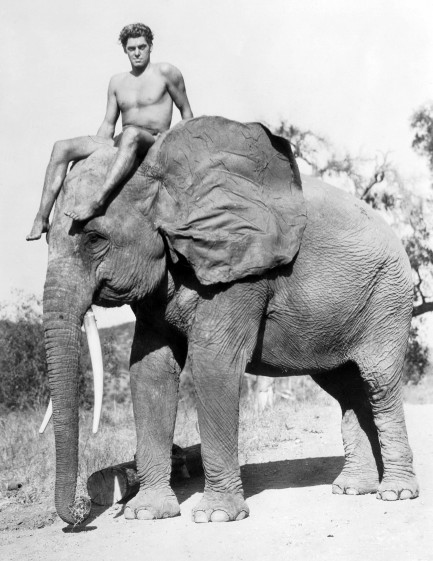 Pick man up. Put man down. Pick man up. Let man sit on my head. I'm about to stomp this fool. Pick man up. Put man down. Pick man up. Let man sit on my head. I'm about to stomp this fool.
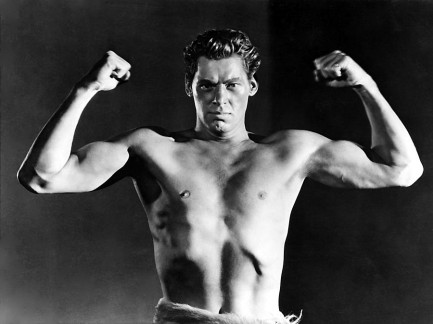 Tarzan invent shaving armpits. Tarzan smooth like eel. Tarzan invent shaving armpits. Tarzan smooth like eel.
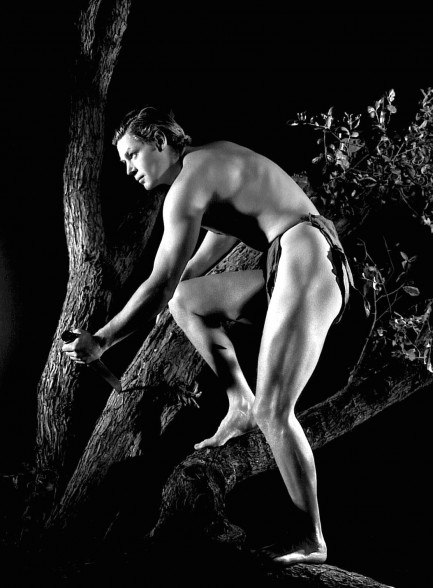 Great pose, Johnny! Just great. And your nuts didn't fall out this time. Excellent! Great pose, Johnny! Just great. And your nuts didn't fall out this time. Excellent!
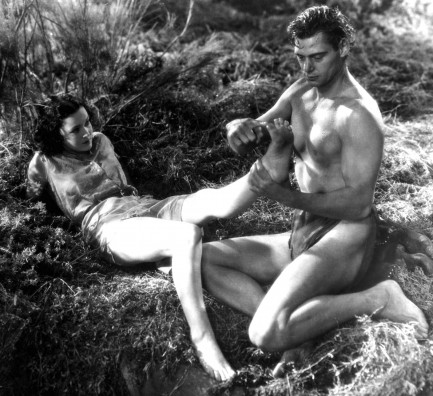 Jane feet funky. Also, Jane need pedicure. Jane feet funky. Also, Jane need pedicure.
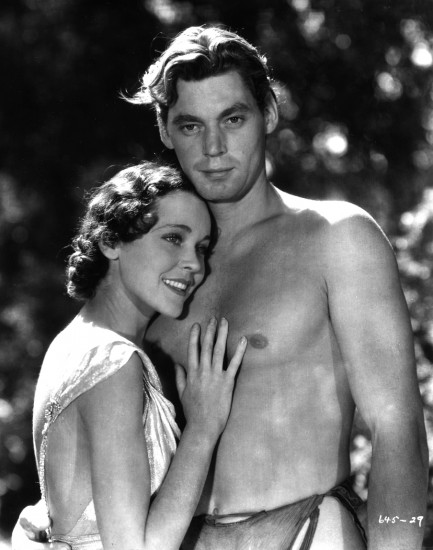 OooOOOoo... what's this here, Johnny? Is that a rock hard chest? I think it is. Who's got a rock hard chest? Johnny's got a rock hard chest... OooOOOoo... what's this here, Johnny? Is that a rock hard chest? I think it is. Who's got a rock hard chest? Johnny's got a rock hard chest...
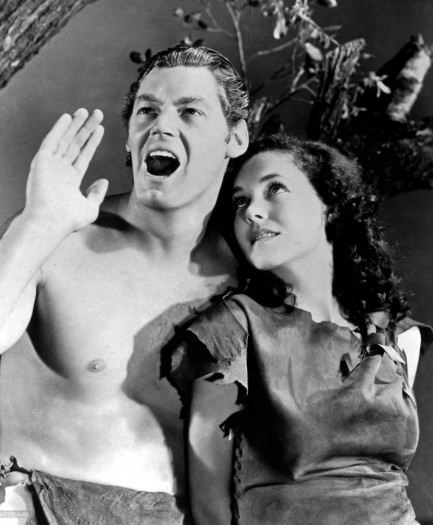 AHHHH-AHAHAHAH-AHAHAHAHA! Can Maureen and I get some goddamned lunch over here! AHHHH-AHAHAHAH-AHAHAHAHA! Can Maureen and I get some goddamned lunch over here!
 For some men divorce is not a tragedy—it's an opportunity. 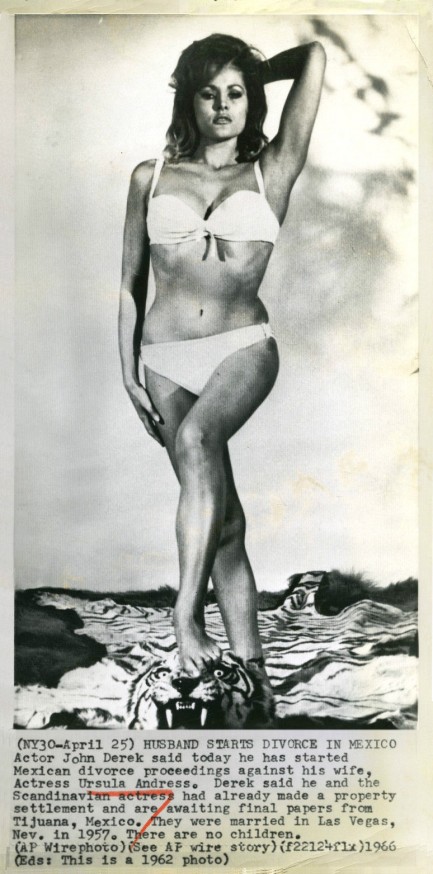
If you've never seen one, this is what an AP wire photo looked like back in 1966. The text at the bottom gives newspaper editors the identity of the subject and some basic facts. No identity needed here—this is Ursula Andress, and the photo is the one widely used when newspapers reported that her husband John Derek was filing for divorce in Tijuana, Mexico. This made us smile because the basic idea here was to show that Derek was out of his mind. Perhaps, however he had already established a pattern of moving on to younger, equally beautiful women. He was first married to Pati Behrs, but divorced her when he met nineteen-year-old Andress. She was thirty when they divorced and he moved on to twenty-three-year-old Linda Evans. And Evans was thirty-two when Derek tossed her over for sixteen-year-old Mary Collins, who you know better as Bo Derek. Andress, Evans, and Collins could have been sisters, and in fact they looked quite a bit like John Derek too (see below). But in Bo he had found not just another doppleganger, but an ingénue willing to star in the poorly made sexually oriented films he liked to direct. These included Fantasies (when Bo was sixteen), the almost competent Bolero, Ghosts Can't Do It, and Tarzan, the Ape Man. Bo and John John Derek stayed together until John died, a span of twenty-two years, so it seems wife number four cured him of his habit of trading for younger models. Just an interesting Hollywood factoid to enliven your Monday.
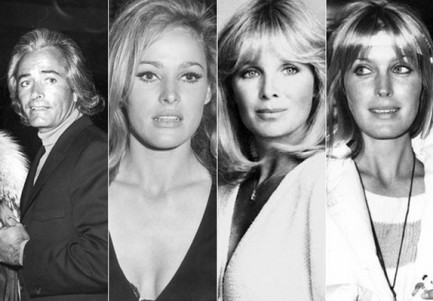
 Johnny Weissmuller brought Tarzan to life seventy-five years ago today. 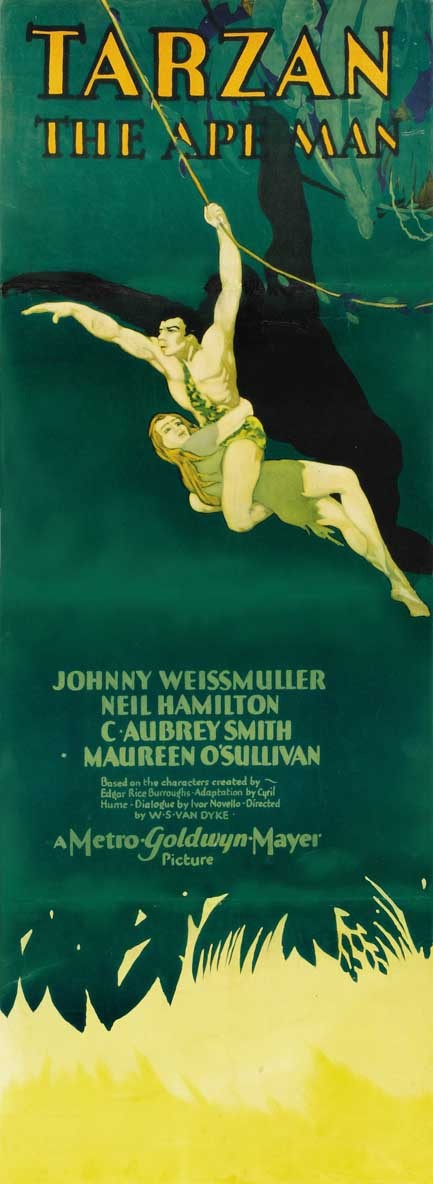
This is one of the most beautiful posters we’ve ever seen. Based on the fiction of Edgar Rice Burroughs, Tarzan the Ape Man was the first offering in a film and television franchise that has been sixty-plus years running. It has taken forms as diverse as Bo Derek’s teasingly awful 1981 softcore remake, Jock Mahoney’s 1962 potboiler Tarzan Goes to India, and Casper Van Diem’s 1998 career-killer Tarzan and the Lost City. None of these would have been possible without the original Tarzan, and that film worked for one reason—Romanian-born hunk Johnny Weissmuller. He was not an actor trying to fit the role of a superman, but a superman trying to fit the role of an actor. He was a six foot three inch Olympic swimmer who won 67 world and 52 national titles, and whose physicality radiated from the movie screen. Men wanted to be him, and women wanted to ride his vine. Tarzan the Ape Man premiered in the U.S. today in 1934.
|
 |

The headlines that mattered yesteryear.
1945—Churchill Given the Sack
In spite of admiring Winston Churchill as a great wartime leader, Britons elect
Clement Attlee the nation's new prime minister in a sweeping victory for the Labour Party over the Conservatives. 1952—Evita Peron Dies
Eva Duarte de Peron, aka Evita, wife of the president of the Argentine Republic, dies from cancer at age 33. Evita had brought the working classes into a position of political power never witnessed before, but was hated by the nation's powerful military class. She is lain to rest in Milan, Italy in a secret grave under a nun's name, but is eventually returned to Argentina for reburial beside her husband in 1974. 1943—Mussolini Calls It Quits
Italian dictator Benito Mussolini steps down as head of the armed forces and the government. It soon becomes clear that Il Duce did not relinquish power voluntarily, but was forced to resign after former Fascist colleagues turned against him. He is later installed by Germany as leader of the Italian Social Republic in the north of the country, but is killed by partisans in 1945. 1915—Ship Capsizes on Lake Michigan
During an outing arranged by Western Electric Co. for its employees and their families, the passenger ship Eastland capsizes in Lake Michigan due to unequal weight distribution. 844 people die, including all the members of 22 different families. 1980—Peter Sellers Dies
British movie star Peter Sellers, whose roles in Dr. Strangelove, Being There and the Pink Panther films established him as the greatest comedic actor of his generation, dies of a heart attack at age fifty-four.
|

|
|

It's easy. We have an uploader that makes it a snap. Use it to submit your art, text, header, and subhead. Your post can be funny, serious, or anything in between, as long as it's vintage pulp. You'll get a byline and experience the fleeting pride of free authorship. We'll edit your post for typos, but the rest is up to you. Click here to give us your best shot.

|
|




 Needless to say, this flick is not flattering to Africans, African Americans, or African anyones. As for what the little person community thinks about fifty of their number covered in shoe polish, you'd have to ask a little person. We don't know any. But we seriously doubt they like it.
Needless to say, this flick is not flattering to Africans, African Americans, or African anyones. As for what the little person community thinks about fifty of their number covered in shoe polish, you'd have to ask a little person. We don't know any. But we seriously doubt they like it. Pick man up. Put man down. Pick man up. Let man sit on my head. I'm about to stomp this fool.
Pick man up. Put man down. Pick man up. Let man sit on my head. I'm about to stomp this fool. Tarzan invent shaving armpits. Tarzan smooth like eel.
Tarzan invent shaving armpits. Tarzan smooth like eel. Great pose, Johnny! Just great. And your nuts didn't fall out this time. Excellent!
Great pose, Johnny! Just great. And your nuts didn't fall out this time. Excellent! Jane feet funky. Also, Jane need pedicure.
Jane feet funky. Also, Jane need pedicure. OooOOOoo... what's this here, Johnny? Is that a rock hard chest? I think it is. Who's got a rock hard chest? Johnny's got a rock hard chest...
OooOOOoo... what's this here, Johnny? Is that a rock hard chest? I think it is. Who's got a rock hard chest? Johnny's got a rock hard chest... AHHHH-AHAHAHAH-AHAHAHAHA! Can Maureen and I get some goddamned lunch over here!
AHHHH-AHAHAHAH-AHAHAHAHA! Can Maureen and I get some goddamned lunch over here!